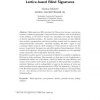92 search results - page 2 / 19 » Generating Shorter Bases for Hard Random Lattices |
120
click to vote
STOC
2005
ACM
15 years 12 months ago
2005
ACM
Our main result is a reduction from worst-case lattice problems such as GAPSVP and SIVP to a certain learning problem. This learning problem is a natural extension of the `learnin...
81
Voted
JCSS
2007
14 years 11 months ago
2007
We consider the problem of counting the number of lattice vectors of a given length and prove several results regarding its computational complexity. We show that the problem is â™...
121
click to vote
EUROCRYPT
2012
Springer
13 years 2 months ago
2012
Springer
We provide an alternative method for constructing lattice-based digital signatures which does not use the “hash-and-sign” methodology of Gentry, Peikert, and Vaikuntanathan (ST...
107
click to vote
ASIACRYPT
2010
Springer
14 years 9 months ago
2010
Springer
Blind signatures (BS), introduced by Chaum, have become a cornerstone in privacy-oriented cryptography. Using hard lattice problems, such as the shortest vector problem, as the bas...
115
click to vote
FOCS
1999
IEEE
15 years 4 months ago
1999
IEEE
Various efforts ([?, ?, ?]) have been made in recent years to derandomize probabilistic algorithms using the complexity theoretic assumption that there exists a problem in E = dti...

